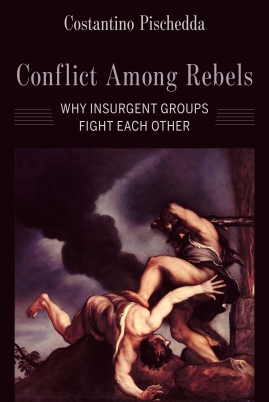
Conflict Among Rebels: Why Insurgents Fight Each Other (Columbia University Press)
[get it at a 20% discount with the promo code CUP20 here]
Why do rebel groups frequently fight one another rather than cooperating against their common enemy – the state? This completed book manuscript presents a theory of inter-rebel war and tests it with a combination of case studies and statistical analysis
My answer to the puzzle of inter-rebel war weaves together insights from International Relations theory and the study of ethnic politics. I argue that, far from being the result of myopia or irrational urges, inter-rebel war is a calculated response by rebel organizations to opportunities for expansion and threats emanating from their environment. Specifically, inter- rebel war tends to break out in two scenarios: (1) when rebel organizations face windows of opportunity to eliminate weaker coethnic rivals at low costs and risks, thanks to a stark military advantage and the fact that the government temporarily poses a limited threat, thus establishing themselves in a hegemonic position in the rebel camp; (2) when rebel organizations face windows of vulnerability, i.e., a drastic deterioration of their relative power relative to coethnic rival, which they try to escape with a desperate military gamble. In both cases, military considerations, that is, the inter-rebel balance of power and the degree of threat posed by government forces in a specific moment, and the ethnic identities of rebel organizations shape their calculus. Somewhat counterintuitively, for two reasons coethnic rebel organizations represent both especially frightening threats and enticing opportunities for expansion for one another. First, the fact that coethnic rebel organizations aspire to control the same ethnic communities makes their conflict of interest stark and immediate. Second, coethnic rebel organizations can reasonably expect to be able to harness the resources of defeated rivals (in particular, recruitment pools, logistical support networks, and tax bases as well as some of their rank and file) due to ethnic parochialism, that is, the well-document tendency of individuals to be particularly cooperative with and favor members of one’s own ethnic group. As a result, inter-rebel war promises the organization that prevails an improved threat environment and wider pool of resources to deploy against the government. By contrast, because of their less immediate conflicts of interest and inability to expand at each other’s expense, non-coethnic rebel organizations are less likely to fight one another.
The book adopts a mixed-method approach to test this argument. The main emphasis is on in- depth case studies of a series of insurgencies in Iraq and Ethiopia. This analysis combines secondary literature with primary sources collected during fieldwork in Iraq, Ethiopia, and several European countries, including interviews with former insurgent leaders, their memoirs, and archival materials. To assess whether the argument travels beyond these settings, I also conducted shadow case studies of the civil wars in Sri Lanka, Lebanon, and Syria as well as statistical analysis of all pairs of rebel groups facing the same government in the post-cold war era.
